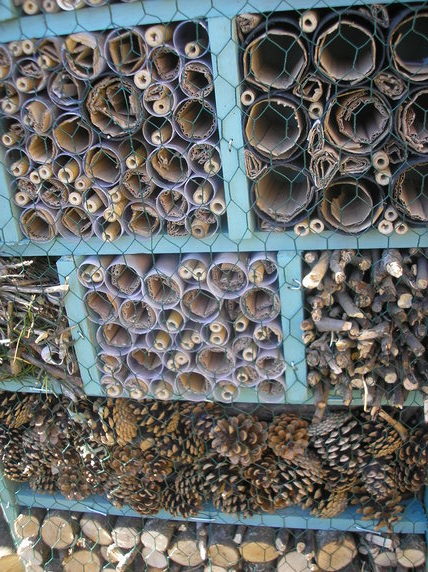In her Growing up North series for Northern Soul, our Gardening Correspondent Claire Fleetneedle looks at the unique challenges faced by gardeners up North and shares tips, ideas and horticultural happenings across the region.
Early Spring is a time when I’m out in the garden every chance I get which, given my health and job, isn’t nearly as often as I’d like. Since the COVID-19 crisis, I’ve suddenly found I have a lot more time on my hands and, self-isolating at home like most people, I wondered how to fill my days.
A few weeks before the crisis I’d read that we have more than 250 species of bees in the UK. Some 90 per cent are solitary and, like most bee populations, are under threat of extinction. Since I began growing largely bee-friendly plants in my garden I have observed many different types of solitary bee. So, building a home for them seemed a good idea and I’d started the foundations of a large bee hotel. During this unusual period, it felt constructive to use my time to complete the structure, partly to keep me busy, but mostly to do my bit to help the bees.
About a month ago, on a trip to the local tip, I witnessed someone about to chuck away a pair of ornamental garden ladders, the sort that can be propped against a wall and plants placed on every rung. While I have since been told you are not supposed to do this, I asked the chap if I could have the ladders and he was more than happy for me to take them. Regardless of any tip site rules, surely it’s better for items to be recycled where possible?
I broke the ladders apart, fashioning an oblong frame from the sides and saving the wooden rungs. The frame measured 14cm deep by 110cm high and 61.5cm wide. Now, this is a large structure and if you are planning to make one of your own, I would suggest perhaps a slightly smaller one but with a similar depth (14-15cm). The depth is important for solitary bees (who will hopefully move in) as it gives them space to house their larvae and live during their short season.
Given the mammoth dimensions of my bee/bug hotel, I needed to create sections and, after searching through the shed, I found our wooden washing line prop. We don’t often use it and it seemed daft to buy more wood, so I cut it up to create four shelves. It is vital that any bee hotel has a secure back as it stops parasites from getting in and eating the larvae, so I sourced a piece of an old kitchen unit to do the job.
 Then I found a chunk of wood from some trellising that our next-door neighbours had kindly given us last summer, cutting it to create sections along the first three shelves. My drill is fairly useless so I used a hammer and some large nails for the entire construction. Next, I fashioned a little peaked roof by fixing a 5cm by 2.5cm strip of wood along the top, after which I nailed sections of the original wooden ladder rungs at an angle from the strip to create a roof. I also added two feet to the bottom using some wooded offcuts.
Then I found a chunk of wood from some trellising that our next-door neighbours had kindly given us last summer, cutting it to create sections along the first three shelves. My drill is fairly useless so I used a hammer and some large nails for the entire construction. Next, I fashioned a little peaked roof by fixing a 5cm by 2.5cm strip of wood along the top, after which I nailed sections of the original wooden ladder rungs at an angle from the strip to create a roof. I also added two feet to the bottom using some wooded offcuts.
When all this was finished, I realised that the old kitchen unit board and the roof would not be watertight enough to keep the hotel dry, so I searched through the shed again and pulled out a roll of strong oil cloth-type fabric which my friend, who lives down the road, had given to me last year. Much like me, she hates chucking anything away and we often swap useful stuff. Using panel pins I tacked the cloth over the back of the unit and folded it over the roof. It can get wild up here, so I had to attach it securely.
Most online sources say not to use any kind of paint or glue in the construction of an insect hotel, but given I live in a reasonably wet part of the world, I decided the hotel would most likely last longer if I painted the frame. So I used the last of some fence paint I had under the sink. Once this had dried, I began to fill each section. Suspecting that beetles, earwigs and woodlice might live in the lower parts, I used pine cones left over from Christmas as well as twigs and logs. A few years ago, my neighbours across the road had some old dead trees cut down in their garden and they offered me some of the wood, knowing I was likely to use it for something or other. The tree surgeon was a lovely chap and cut each log into manageable pieces and brought them over. They’ve been drying in the shed for two years and I only needed to shorten a few pieces to fit into the lower shelves.
 By this point I was in self-isolation and, although I’d planned to buy giant bamboo canes and various other eco-friendly items to fill it, I was now stuck at home without having sourced these items. As luck would have it, our other next-door neighbours had ordered a skip and were emptying their garage. I couldn’t believe my luck (talk about timing) when they gave me some nice fat bamboo canes as well as Perspex tubing which was packaging from fishing rods. My other neighbours (who had gifted the trellising) gave us an old hose pipe and some rubber tubing.
By this point I was in self-isolation and, although I’d planned to buy giant bamboo canes and various other eco-friendly items to fill it, I was now stuck at home without having sourced these items. As luck would have it, our other next-door neighbours had ordered a skip and were emptying their garage. I couldn’t believe my luck (talk about timing) when they gave me some nice fat bamboo canes as well as Perspex tubing which was packaging from fishing rods. My other neighbours (who had gifted the trellising) gave us an old hose pipe and some rubber tubing.
I spent several days cutting everything to the correct length and sanding all the rough edges. It is particularly important that any Perspex or wooden edges are sanded smooth as jagged edges can damage bees’ wings. Once all these were in place, I put chicken wire over the front and secured it with galvanised staples which my neighbour had found in his garage clear out. This was to ensure that birds or other animals didn’t pull anything out. When I finally finished (which was a massive relief), my partner and I moved it to the top of the garden in a sheltered south east-facing spot, as I’ve read this is what the bees and bugs prefer.
That evening I began to do a bit more research into bee and bug hotels to help me to write this article and was horrified to read that all my rubber and plastic tubing was dangerous for the bees. It turns out that condensation can build and create mould which kills the bee larvae. I was so horrified by the idea of causing any harm to the bees and insects I was trying to help that I was up with the lark the following morning to correct my mistakes. I removed every piece of rubber tubing through the chicken wire with long-nosed pliers. I decided to keep the Perspex tubing as it seemed like the plexiglass tubing which many retailers sell to house solitary bees. To avoid condensation, I lined each tube with corrugated cardboard, which I retrieved from of our recycling bin, and I placed newly-cut cane pieces in some of the other plastic tubing leaving room for air circulation.
 In one section I replaced the cut hosepipe with some dried leaves and flowers. I added small bunches of bog grass which I knew would dry well and some small sticks. I had read that bees sometimes like to live in old snail shells, so I scoured the garden and found a handful which I wedged among the sticks, herbs and grasses. In other sections I wedged broken twigs and rolls of cardboard to encourage other insects. After a few hours I had managed to completely change the hotel and it was looking far more natural and, hopefully, more inviting to the insect population.
In one section I replaced the cut hosepipe with some dried leaves and flowers. I added small bunches of bog grass which I knew would dry well and some small sticks. I had read that bees sometimes like to live in old snail shells, so I scoured the garden and found a handful which I wedged among the sticks, herbs and grasses. In other sections I wedged broken twigs and rolls of cardboard to encourage other insects. After a few hours I had managed to completely change the hotel and it was looking far more natural and, hopefully, more inviting to the insect population.
Only time will tell if it manages to entice bees and bugs, but one thing is clear: I could never have managed it without the generosity of my friends and neighbours. I’ve named the hotel ‘Claireridges’ but it was most definitely a collaboration. In these difficult times it’s comforting to be surrounded by such kindness and community spirit.
Happy Bee Hotel Building.
By Claire Fleetneedle, Gardening Correspondent
Images by Claire Fleetneedle











